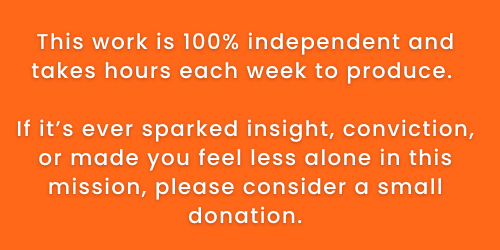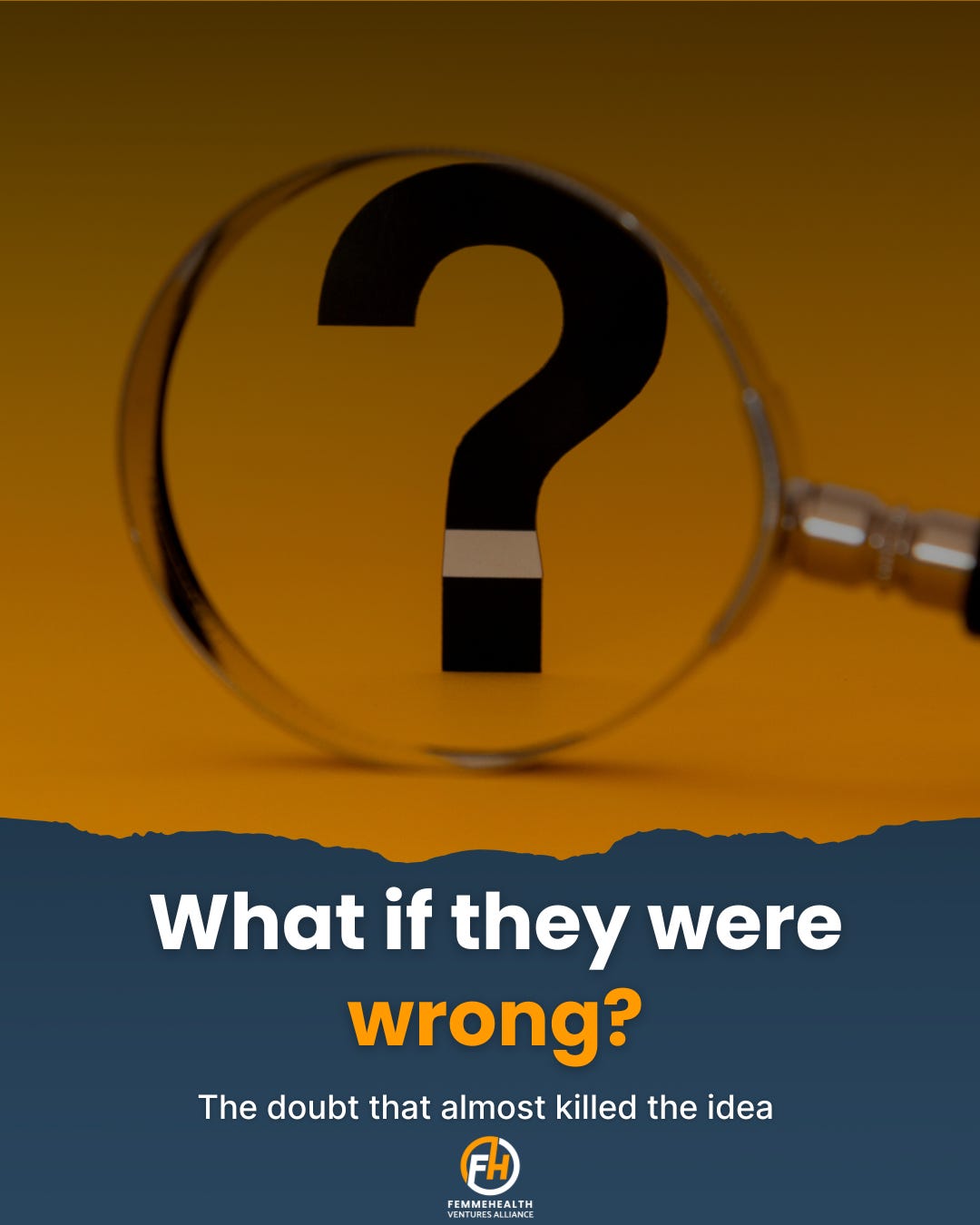The Market They Said Didn’t Exist And Why I Built Anyway
They told me women’s health wasn’t worth investing in. I couldn’t let that be the end of the story.

This newsletter is 100% free. But it takes hours each week to research, write, and produce at this level. Here are 5 ways to support my work: 1. click “❤️” to amplify 2. subscribe 3. share this publication 4. buy me coffee 5. become a partner
Connect and collaborate with me here! email | LinkedIn | Instagram
At a dinner a few years ago, I found myself seated across from a respected investor. We were discussing sectors of interest, and when it was my turn, I said I was exploring women's health.
He paused. “Ooh,” he said, half-smiling. “Not a lot going on there. I’d be surprised if you find something worth investing in.”
I pressed a little. What about diagnostics? Cardiometabolic? Menopause care? He shrugged. “There’s no market.” The table moved on. But I didn’t.
Everyone else forgot it by dessert. I’ve been unpacking it ever since.
Get Early Access to my upcoming Book - The Billion Dollar Blind Spot
The Moment That Stayed With Me
Something about that exchange stayed with me not because it was rude (it wasn’t), but because it was final. The kind of statement that closes doors before they can even be built. The kind that erases not just opportunity, but imagination.
Still, I understood where it came from. When capital looks at a market and sees fragmentation, unmet clinical need, and a lack of exits, it calls it high risk. When I looked at that same landscape, I saw innovation hiding in plain sight.
But for months, I sat with the doubt: Was I seeing something that didn’t exist? Was I trying to solve for a market that no one wanted to build?
What I Found When I Started Digging
I didn’t set out to build anything. I was just following a hunch. I started looking quietly into women’s health startups. I read white papers, scrolled through clinical trials, talked to founders. I wasn’t chasing headlines or unicorns. I was mapping the terrain no one else seemed to be watching.
What I found wasn’t scarcity. It was strategy that hadn’t been matched with capital. Brilliant teams building real science in areas like pelvic pain, hormone diagnostics, and menopause dismissed not because the science was weak, but because the system didn’t know how to value it.”
On the other side, I met people mostly women who wanted to invest in something that mattered. But they didn’t know where to start. The on-ramps weren’t built for them. The guidance didn’t exist.
That’s when something clicked.
There was a market. But it wasn’t a pipeline problem. It was a capital coordination problem. And that’s where I thought: maybe I can help.
I Almost Didn’t Build It
I had the idea for the Investor Readiness Program a year before I ever said it out loud. I told myself the timing wasn’t right. I had too many responsibilities. Who was I to build something like this?
There was no guarantee anyone would sign up. No confirmation it would land.
And the more I researched, the more complex it seemed. Regulation. Risk frameworks. Valuation in early-stage health. It felt too big to teach in a way that made people feel confident rather than overwhelmed.
So I almost didn’t build it.
But then I started writing about the capital gap. I started posting about deal flow, market blind spots, and what it means to invest with both conviction and care.
And the responses came…quietly at first. A message. A reply. A forwarded article.
“I’ve been wanting to invest in women’s health but didn’t know where to begin.”
“I’m a doctor and an angel investor, and I need a better framework.”
“I didn’t know other people were thinking about this too.”
That resonance was unmistakable. The demand wasn’t loud, but it was real.
❤️ Enjoying this? If this post sparked something for you, click the ❤️ at the bottom. It helps more than you know and tells me you're reading.
What Shifted
Instead of asking “Will there be enough people?” I started asking “What would make this actually useful?”
I interviewed early investors, clinicians, skeptical VCs. I mapped out the key friction points:
Lack of credible deal flow
Uncertainty around scientific validation
No clear frameworks for assessing women’s health business models
And I began designing around those pain points piece by piece.
The result became a program that’s less like a course and more like a compass:
Practical. Evidence-based. Strategic.
Focused on what real investors need to make confident decisions.
It’s about impact and also about knowing how to evaluate clinical evidence, assess exit potential, and understand regulatory timelines in a space that has been historically underbuilt and underestimated.
Why I Built It Anyway
I didn’t build this because I had free time.
I built it because I kept hearing the same thing from smart, capable people:
“I want to invest in women’s health. But I don’t know where to begin.”
“I’m tired of waiting for someone else to lead.”
“I want to make capital a catalyst for change.”
The Investor Readiness Program is for them. For you. For the version of me that once sat at that dinner and quietly wondered if the market existed at all.
It does.
We just have to stop waiting for permission to build it.
If This Resonates…
I built this program for people who have been watching from the sidelines, curious, but unsure where to start. If that’s you, the waitlist is open. We begin in September.
👉 Join the Investor Readiness Waitlist
Only 15 spots per cohort. No jargon. No judgment. This isn’t a course. It’s a movement in motion. The next chapter starts in September.
Join Our Network
Are you building or backing similarly credible, under-the-radar solutions in women’s health?
We want to hear from you. Reach out privately or reply to this post. FHV curates brands and breakthroughs that deserve broader attention in the women’s health ecosystem.
Coming in July 2025:
🎧 Blindspot Capital: The Podcast
Formerly FemmeHealth Founders, our podcast relaunches this summer under a sharper lens and a bolder name. Blindspot Capital explores the undercurrents shaping health innovation from the deals that stall to the systems that silence. This season, we speak to the people shifting what gets seen, funded, and scaled. Confirmed guests include:
Ida Tin (Clue, FemTech Assembly) on founding the femtech category
Lisa Suennen (Venture Partner & Healthtech strategist) on how institutional capital moves.
Sabrina Johnson (CEO Daré Biosciences) on what it takes to build a publicly listed women’s health company
👉 Subscribe to Blindspot Capital wherever you get your podcasts, or listen directly on Substack.
I write weekly at FemmeHealth Ventures Alliance about capital, care, and the future of overlooked markets. If you are building, backing, or allocating in this space, I’d love to connect.
Disclaimer & Disclosure
This content is for informational and educational purposes only. It does not constitute financial, investment, legal, or medical advice, or an offer to buy or sell any securities. Opinions expressed are those of the author and may not reflect the views of affiliated organisations. Readers should seek professional advice tailored to their individual circumstances before making investment decisions. Investing involves risk, including potential loss of principal. Past performance does not guarantee future results.






This is spooky. I am in the midst of writing a research article about disparities in menopause care and research and your post popped up first today. I think you’re right. The interest is absolutely there. Coordination is the issue.
The fact that we’re still citing the SWAN study from 1994(!) and dealing with vague answers about menopause is wild while investments in men’s health have resulted in a great deal of breakthroughs, most notably, a medical solution for ED.
I refuse to believe that researchers can’t find a way to cure hot flashes.
I'm really interested to see where this goes. In my 50's I was diagnosed with a couple of Autoimmune conditions, all of which occur 4-5 times greater in women than men, and most commonly in perimenopause. "Could this be related to hormones?" I asked. "No".
Zero explanation, zero interest.
While I was being told to get my husband to help with the housework (how many assumptions can we unpack in that?!) men with the same condition are given support with a loss of libido.
Seriously?!
So it's great to hear that you're looking to build better funding for female healthcare. I'll be watching those opportunities.